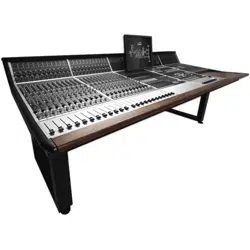Loading ...
Loading ...
Loading ...

THE MULTI-TRACK BUSES
For simple sessions, it is typical to route the SF
channel path to its corresponding Multi-track
Output using the Bus Routing Matrix. This
sends the signal to your recording device.
To control the amount of level being sent to
the output simply bring up the Short Fader
to a point where you get a healthy signal into
your recording device. Setting the fader at
0dB means that the signal isn’t boosted or
attenuated when it is sent to the Multi-track
Outputs, which is ideal for most situations.
However, you can also use the Short Fader in a
more creative manner:
If you are using multi-track tape machine
instead of a DAW, slightly increasing the level
of your Multi-track Outputs via the Short Fader
can give you pleasing magnetic saturation. This
isn’t applicable to all recording scenarios, but
when used well, can give you a warm, punchy
sound that is great on drums and guitars.
In a similar vein, you can use the Short Fader
to reduce the output, allowing you to increase
the gain of the preamp. Although the Audient
preamp design is relatively clean, it does start
to tighten up and get slightly ‘warmer’ as you
start to push it harder. Again, while this isn’t
suitable for all situations, it can be a great
way of adding additional richness or body to a
recording.
MONITORING RECORDED TRACKS
To monitor your recorded tracks from your
recording device (DAW/Tape machine) bring
up the Long Faders and press the Long Fader
Mix button. This sends the audio to the Mix Bus
which is then sent to the monitors. This enables
you to monitor what is happening in your DAW
on the Long Faders and lets you start building
a mix as you’re tracking, all without making
changes to your input signals.
FOLDBACK
You can use ASP8024-HE’s two Cue Mixes,
to allow musicians to hear the live input and
click/guide tracks from your session.
To bring a click/guide track onto the console,
it needs to be sent to the DAW/Tape Returns
on a channel (or multiple channels). This brings
the signal onto the LF path of that channel.
To help keep your session easy to navigate,
it is recommended that you keep the guide
tracks separate from the recording channels
(e.g. bring them in on the last channels on the
console).
To send the click/guide track, turn up the Cue
Mix knobs on the channels you want to send.
The Cue Mix knobs default to the LF path, so
to send the live input to the artist, make sure
the SF button is engaged next to the Cue mix
knobs. Use the Cue Mix Solo button found
on the Master Section to monitor what will
be sent to the artist, and then ensure the Cue
Mix Master is turned up.
The Cue Mix can be routed to the Foldback
Output using the “Live Room and Foldback
Section” of the Master Section. Press the Cue
buttons under Foldback 1 to assign the Cue
Mix to the Foldback Output. It is possible to
create a stereo foldback signal using the two
cue mixes, using Cue A as the left channel,
and Cue B as the right channel.
TRACKING WITH EFFECTS
When tracking, it is possible to make use
of the console EQ as well as using Channel
Inserts, allowing you to commit effects as
you record. To insert a piece of equipment,
press the Insert Active button in the Mic/Line
section of the channel strip. For EQ, ensure
that the SF and IN buttons are engaged on the
EQ band that you want to use. It is possible to
split the Shelf and Parametric EQs between
the Long and Short Faders by sending only
one to the SF path.
35
Using asp8024-HE
Loading ...
Loading ...
Loading ...
